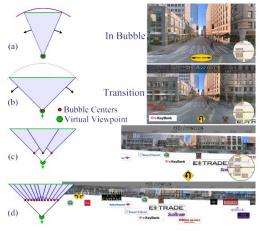July 29, 2010 report
Microsoft Street Slide threatens to eclipse street view rivals (w/ Video)

(PhysOrg.com) -- Microsoft has unveiled "Street Slide," which gives viewers 360-degree multi-perspective panoramas ("bubbles") of a city streetscape. The system should rival Google's Street View and Bing Maps' Streetside.
Researchers Johannes Kopf, Billy Chen, Richard Szeliski, and Michael Cohen say their system provides an uninterrupted transition between the bubbles and multi-perspective panoramas, and a dynamic stitching together of the views that simulates either a perspective view or a hyper-perspective view like viewing the street from a distance. This overcomes limitations of other systems, such as a reduction in resolution as the viewer zooms in to a view, and provides a sense of parallax to make the view seem more realistic as the viewer "street slides" along the street façade.
The team demonstrated their Street Slide system using images of a streetscape in Seattle, Washington, and carried out a study that tested the system against the Google and Bing software. The 20 volunteers found it easier and significantly quicker (an average of 17 seconds faster) to locate a specific building on an unfamiliar street using the Street Slide system.
Street Slide presents the viewer with slices of many images, making it possible to see all the buildings on a street at the same time, and to slide sideways along the street. The Google and Bing systems also provide panoramic photographs or bubbles, but the viewer must jump from one bubble to the next and it is not possible to "travel" smoothly down the virtual street.
Microsoft senior scientist Michael Cohen explained that the bubbles provide only a limited view, even though a viewer can rotate within a bubble to look in any direction. He said "You want to back up until you can see the whole street but you can’t because the buildings on the other side are in the way." The new system creates that viewpoint by stitching together images taken from all the bubble panoramas on the street. As the view zooms out of the bubble the long distance view is presented, but the user can also return to the classic bubble view at any time.
The street views are wide, leaving room at the top and bottom for additional information such as the street name and numbers, business information, a map and navigational aids. Cohen said the space could also be used for advertising, or even social information such as the locations of people linked into a social network.
The Street Slide system was introduced at Microsoft Research’s publication page, and will be presented in Los Angeles this week at the SIGGRAPH 2010 computer graphics conference. The team is already developing a version of Street Slide compatible with the iPhone.
More information: Research paper (PDF): research.microsoft.com/en-us/u … per/street_slide.pdf
© 2010 PhysOrg.com





















